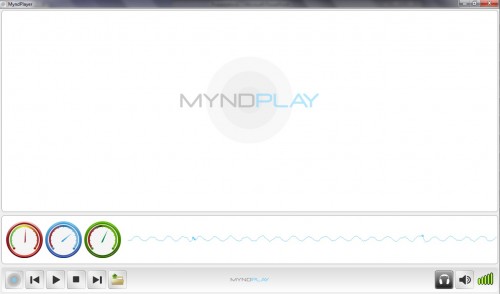I’ve been trying out MyndPlay, a video-based neurofeedback training platform which embeds neurofeedback exercises into interactive movies. Think Dragon’s Lair but your using your mind instead of a joystick. Of all the NeuroSky apps I’ve tried its my favorite so far, owing a lot to it feeling like an actual product rather than a tech demo. The user interface is slick and provides all the necessary information one would expect from such a product e.g. a live EEG signal.

- MyndPlay User Interface
Training exercises utilise the attention and meditation measures the NeuroSky outputs and an additional measure called “zone”. While the attention and meditation measures are propriety, and I’ve not personally had much luck manipulating them, their friendly enough mental constructs to work with. Although for a neurofeedback training program you’d really want to work with the source signals.
Relaxation is displayed with the blue meter, and attention/focus is displayed by the red meter, the zone meter which reflects a combination of focus/relax is green.
From MyndPlayer User Manual 2.0
What I find strange though is this third measure the program uses. According to the manual its a derivative of the two propriety NeuroSky constructs, as we don’t know what these constructs represent at the signal level (e.g. brainwave frequencies) deriving a new one and assigning it a different mental state is somewhat a dubious move. So why include the additional measure? Not a clue, barring it sounds cool, get in the “zone” to win!
Anyways, as per usual when I don’t understand something, I reverse engineer. After taking a few readings my best guess at describing their zone measure is as follows: –
Zone = (Attention * 0.545) + (Meditation * 0.455)
Assuming the interface displays the immediate attention, meditation and zone values (i.e. no latency during calculation) and my reading of the dial interfaces was correct, the formula approximated zone values for the ten or so samples I collected relatively well. From a technical standpoint I don’t really see a case for the zone measure as the other two measures should be enough. I would imagine the measure is more for show, providing motivation for the user to engage with the training exercises.